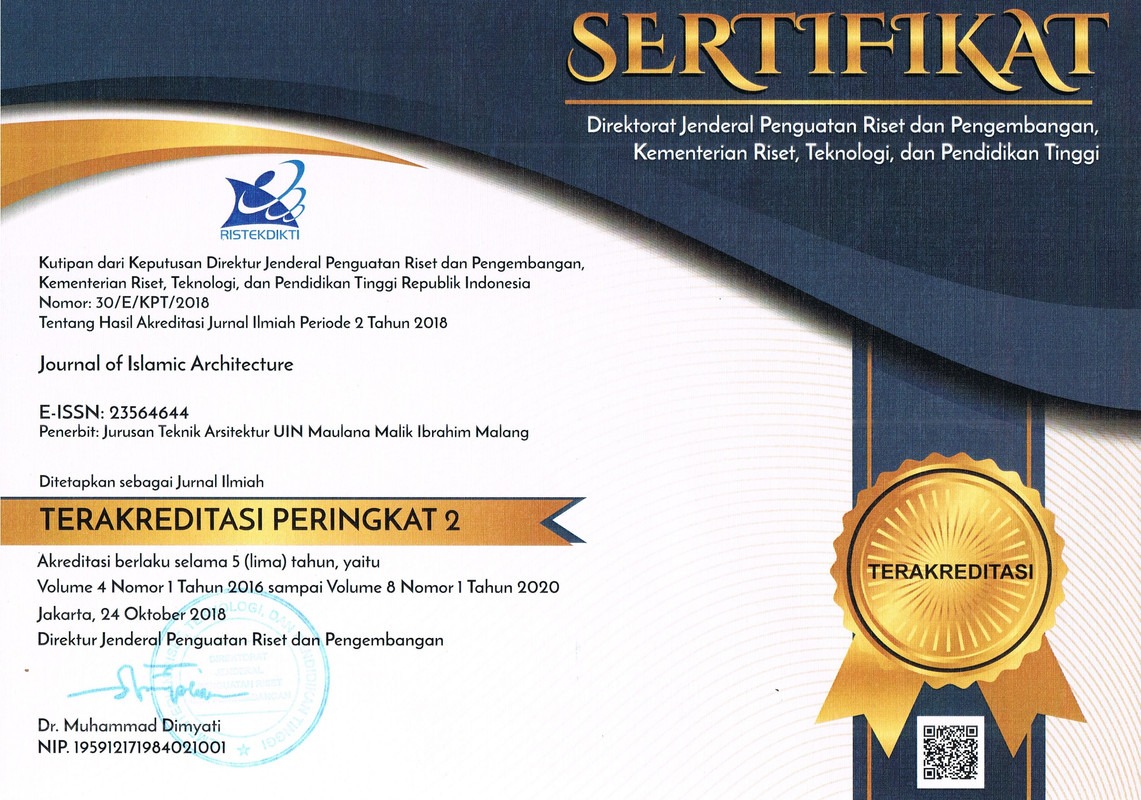ISLAMIC GARDEN CONCEPT IN BUSTANUSSALATIN (GARDEN OF THE KINGS), ACEH, INDONESIA
Abstract
In the 17th century, Nuruddin Ar-Raniry wrote a manuscript about the Aceh Kingdom, namely Bustanussalatin, which means the garden of the kings. Following the working title, in one part of the chapter, he described the garden that was a kingdom in detail. This study aims to determine if the garden existed in that era can deliver as an Islamic garden, considering the Kingdom was ruled based on Islamic law. To answer the part of Bustanussalation which described the garden was carried out using the content analysis method. The coding and sorting based on the concept of Islamic garden based on Islamic source, which is the Quran and Hadits, which has been carried out by other research. The result showed that the garden implemented the Islamic garden concept in picturing the garden in Heaven. However, it can not be denied that some restriction in sharia was disobeyed in the garden in using the elements of the causing the garden element historical garden.
Keywords
Full Text:
PDFReferences
D. Lombard, Kerajaan Aceh Zaman Sultan Iskan-dar Muda (1607-1636). Jakarta: KPG, 2014.
N. AS, “Gunongan Kesultanan Aceh (Kajian Arkeologi Sejarah),” Jurnal Adabiya, vol. 16, no. 31, pp. 29–46, Agustus 2014.
J. Harun, "Bustan Al‐Salatin , 'the garden of kings': a universal history and ADAB work from seventeenth‐century ACEH," Indonesia and the Malay World, vol. 32, no. 92, pp. 21–52, Mar. 2004, doi: 10.1080/1363981042000263444.
S. B. A. L. Khan, Sovereign Women in a Muslim Kingdom The Sultanahs of Aceh, 1641-1699. Singapore: NUS Press, 2017.
N. Man, Jamil, and Yusof, "The elements of Landscape in Islamic Courtyard Design: Case Study of Bayt Al-Suhaymi Museum in Cairo, Egypt and Alhambra Granada, Spain," International Journal of Academic Research in Business and Social Sciences, vol. 7, no. 3, pp. 653–667, 2017.
N. Ansari, "The Islamic Garden." CEPT Universi-ty, 2011.
H. H. Md Jani, N. Z. Harun, M. Mansor, and I. Zen, "Islamic Garden Concept in Response to Landscape Design," ajE-Bs, vol. 3, no. 11, pp. 38–45, Nov. 2018, doi: 10.21834/aje-bs.v3i11.332.
A. Reid, Asia Tenggara Dalam Kurun Niaga 1450-1680 Jilid 2: Jaringan Perdagangan Global. Jakar-ta: Yayasan Pustaka Obor Indonesia, 2020.
A. Lac, "Content Analysis," in Encyclopedia of Adolesence, 2nd ed., Switzerland: Springer International, pp. 1–5.
K. A. Arief, Ragam Citra Kota Banda Aceh: Inter-pretasi Sejarah, Memori Kolektif, dan Arketipe Arsitekturnya. BRR NAD-Nias: Pustaka Busta-nussalatin, 2008.
M. Jannah, W. Q. Mugnisjah, and A. Gunawan, “Kajian Konsep Taman Islam Berdasarkan Al Quran dan Hadits,” El-Harakah, vol. 17, no. 1, p. 1, Sep. 2015, doi: 10.18860/el.v17i1.3082.
Z. Poursafar, "The function of Plants in Asian Gardens: A Review on Asian Landscape Architecture," International Journal of Applied Environmental Sciences, vol. 11, no. 2, pp. 525–533, 2016.
The Holy Quran.
DOI: https://doi.org/10.18860/jia.v6i3.10840
Refbacks
- There are currently no refbacks.






